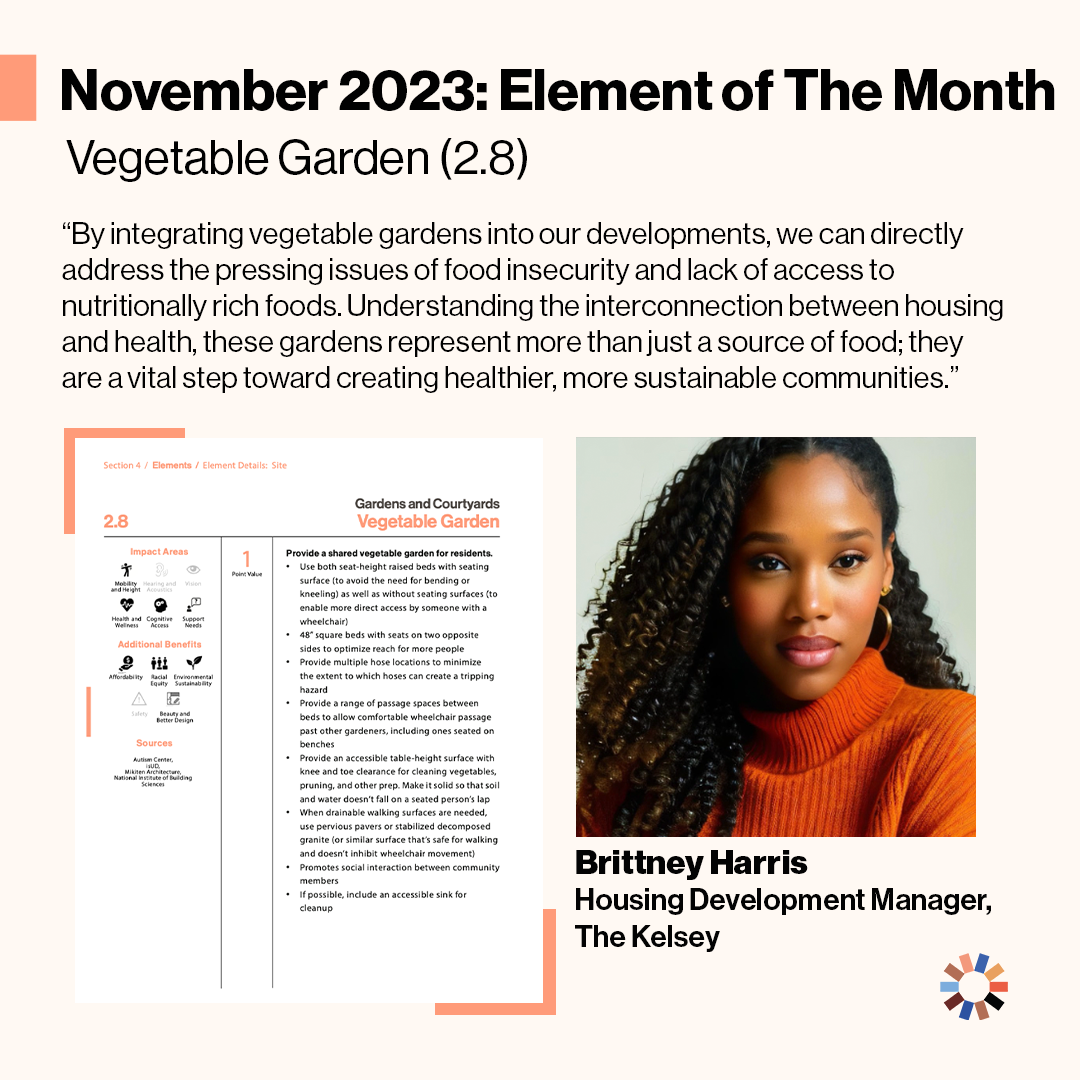The Inclusive Design Standards equip designers, builders, and developers with a guideline and framework for disability-forward housing creation. They highlight cross-disability accessibility and design decisions that are anchored in inclusion. Each month, we feature one of our partners and the Element they’re most excited about.
Brittney Harris | Housing Development Manager | The Kelsey

We are delighted to highlight our growing staff this month. We asked our newest Housing Development Manager, Brittney Harris, about an element that she feels passionately about, and the Vegetable Garden was an “obvious choice” for her. Alabama-raised, now Georgia-based, Brittney sees urban gardening as a tangible way to combat the lack of healthy, fresh food in areas better known as food deserts–a commonality among low-income neighborhoods. Brittney explains that vegetable gardens “not only nourish the body but also foster a sense of empowerment and community, [which is] crucial in areas where access to fresh, healthy food is scarce.” Ultimately, they “embody a solution that is both practical and profoundly impactful.”
Disability-forward Element: Vegetable Garden (2.8)
Description: Provide a shared vegetable garden for residents.
- Use both seat-height raised beds with seating surface (to avoid the need for bending or kneeling) as well as without seating surfaces (to enable more direct access by someone with a wheelchair)
- 48” square beds with seats on two opposite sides to optimize reach for more people
- Provide multiple hose locations to minimize the extent to which hoses can create a tripping hazard
- Provide a range of passage spaces between beds to allow comfortable wheelchair passage past other gardeners, including ones seated on benches
- Provide an accessible table-height surface with knee and toe clearance for cleaning vegetables, pruning, and other prep. Make it solid so that soil and water doesn’t fall on a seated person’s lap
- When drainable walking surfaces are needed, use pervious pavers or stabilized decomposed granite (or similar surface that’s safe for walking and doesn’t inhibit wheelchair movement)
- Promotes social interaction between community members
- If possible, include an accessible sink for cleanup
Design Category: Site
Impact Area(s): Mobility and Height, Health and Wellness, Cognitive Access, Support Needs
Additional Benefit(s): Affordability, Racial Equity, Environmental Sustainability
Why is this element important to you, personally or for the project?
Coming from Birmingham, Alabama, I’ve witnessed the challenges of food deserts that affect much of the city. Astonishingly, more than 70% of Birmingham falls under this category, disproportionately impacting Black and Brown communities. By integrating vegetable gardens into our developments, we can directly address the pressing issues of food insecurity and lack of access to nutritionally rich foods. Understanding the interconnection between housing and health, these gardens represent more than just a source of food; they are a vital step toward creating healthier, more sustainable communities. This approach not only nourishes the body, but also fosters a sense of empowerment and community, crucial in areas where access to fresh, healthy food is scarce. In this way, vegetable gardens stand as my favorite element, embodying a solution that is both practical and profoundly impactful.
How would you explain this element to a 2nd grader?
Imagine living in a big city like Birmingham, where it’s really hard for some people to find fresh fruits and vegetables to eat. This is because there aren’t many stores nearby that sell healthy food. It’s like wanting an apple but only finding greasy hamburgers nearby.
So, what if we could grow our own food, like tomatoes, carrots, and lettuce, right where we live? That’s what a vegetable garden is! We plant seeds in the soil, water them, and take care of them. Then, these seeds grow into yummy vegetables that everyone can eat. This way, no one has to worry about not having fresh and healthy food.
By having a garden in our neighborhood, we make sure everyone, including our friends and neighbors, can eat good food that helps them stay healthy and strong. It’s like sharing a big salad with everyone who lives around us!
What recommendations would you make to someone designing a disability-forward housing project (related to the design standards)?
When recommending to developers the integration of vegetable gardens into a disability-forward housing project, the focus should be on both accessibility and community enhancement. Here’s how you might approach this:
“To developers looking to integrate vegetable gardens into disability-forward housing projects, here are some key recommendations:
1. Accessible Garden Design: Ensure the garden is fully accessible. This includes raised garden beds for wheelchair users, wide and smooth pathways, and easy-to-reach planting areas.
2. Adaptive Gardening Tools: Provide adaptive gardening tools that are easier to handle, such as lightweight, long-handled tools or ergonomic grips, to accommodate residents with various physical abilities.
3. Sensory Plant Selection: Include a variety of plants that stimulate the senses – fragrant herbs, textured leaves, and visually stimulating flowers. This not only makes the garden a sensory delight, but also supports residents with visual or sensory impairments.
4. Community Involvement: Encourage community participation in garden planning and maintenance. This promotes a sense of ownership and community spirit among residents.
5. Educational Programs: Implement gardening workshops and educational programs. These can be tailored to teach residents about nutrition, gardening techniques, and the benefits of fresh produce.
6. Therapeutic Spaces: Design the garden to serve as a therapeutic space. Gardening activities can be incredibly beneficial for mental health and physical well-being.
7. Safety Measures: Incorporate safety measures like non-slip surfaces, adequate seating, and shaded areas to ensure the garden is a comfortable and safe space for all residents.
8. Water Access and Storage: Ensure easy access to water sources for gardening, and consider installing storage sheds for tools and equipment, designed with accessibility in mind.
9. Integration with Dining Services: If the development has communal dining services, integrate the produce grown in the garden into the meal planning. This promotes a farm-to-table concept and encourages healthy eating.
10. Environmental Sustainability: Use sustainable gardening practices, such as composting and water conservation methods, to teach and practice environmental responsibility.
By incorporating these elements, developers can create a garden space that is not just a source of fresh produce, but a vibrant, inclusive, and therapeutic part of the community, enhancing the lives of residents with disabilities.
